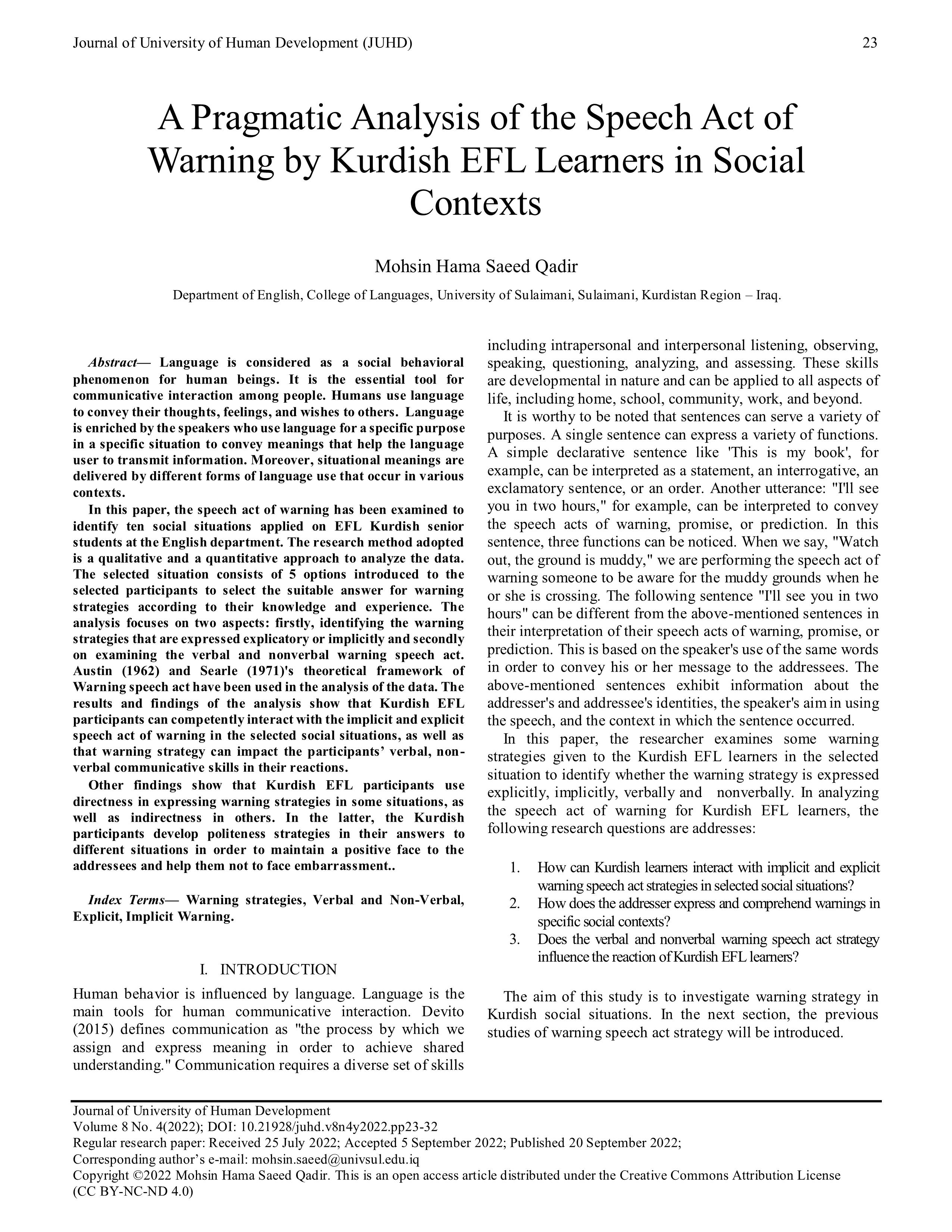A Pragmatic Analysis of the Speech Act of Warning by Kurdish EFL Learners in Social Contexts
DOI:
https://doi.org/10.21928/juhd.v8n4y2022.pp23-32Keywords:
Warning strategies, Verbal and Non-Verbal, Explicit, Implicit WarningAbstract
Language is considered as a social behavioral phenomenon for human beings. It is the essential tool for communicative interaction among people. Humans use language to convey their thoughts, feelings, and wishes to others. Language is enriched by the speakers who use language for a specific purpose in a specific situation to convey meanings that help the language user to transmit information. Moreover, situational meanings are delivered by different forms of language use that occur in various contexts.
In this paper, the speech act of warning has been examined to identify ten social situations applied on EFL Kurdish senior students at the English department. The research method adopted is a qualitative and a quantitative approach to analyze the data. The selected situation consists of 5 options introduced to the selected participants to select the suitable answer for warning strategies according to their knowledge and experience. The analysis focuses on two aspects: firstly, identifying the warning strategies that are expressed explicatory or implicitly and secondly on examining the verbal and nonverbal warning speech act. Austin (1962) and Searle (1971)'s theoretical framework of Warning speech act have been used in the analysis of the data. The results and findings of the analysis show that Kurdish EFL participants can competently interact with the implicit and explicit speech act of warning in the selected social situations, as well as that warning strategy can impact the participants’ verbal, non-verbal communicative skills in their reactions.
Other findings show that Kurdish EFL participants use directness in expressing warning strategies in some situations, as well as indirectness in others. In the latter, the Kurdish participants develop politeness strategies in their answers to different situations in order to maintain a positive face to the addressees and help them not to face embarrassment.
References
Allwood, J. (1977). A critical look at speech act theory. In Dahl (Ed.), Logic, pragmatics, and grammar (pp. 53-69). Lund: Studentlittera tur.
Austin, J.L. (1962). How to do things with words. London: Oxford University Press.
Brown, P., & Levinson, S. (1987). Politeness: Some universals in language usage. Cambridge: Cambridge University Press.
Baker, W., & Bricker, R. H. (2010). The effects of direct and indirect speech acts on native English and ESL speakers’ perception of teacher written feedback. System, 38, 75–84. http://dx.doi.org/10.1016/j.system.2009.12.007
Devito, J. (2015). Human Communication: The basic Course. 13th edition. Pearson Education, Inc.
Holtgraves, T. (1999). Comprehending indirect replies: When and how are their conveyed meanings activated? Journal of Memory and Language, 41(4), 519–540.
Jack C. Richards, Schmidt (2010). Longman Dictionary of Language Teaching and Applied Linguistics. 4th edition.
Korta, K. & Perry, J. (2007a). How to say things with words. In Savas L. Tsohatzidis (ed.), John Searle’s philosophy of language: Force, meaning, and thought, 169–189. Cambridge University Press.
Mills, S. (2003). Gender and politeness. Cambridge: Cambridge University Press. 270 pp., ISBN Hb 0 521 81084 1, Pb 0 521 00919 7
Nicoloff, F. (1989). 'Threats and Illocutions,' Journal of Pragmatics, 13 (1989): 501-522.
QUIRK, R., GREENBAUM, S. (1990) A Student’s Grammar of the English Language, Harlow: Longman, Ltd.
Recanati, F. (1987b). Contextual dependence and definite descriptions. Proceedings of the Aris-totelian Society 87: 57-73.
Searle, J. (1971). What is a speech act? In The philosophy of language. Edited by John Searle. Oxford: Oxford University Press.
Wogalter, M. S., & Silver, N. C. (1995). Warning signal words: Connoted strength and understandability by children, elders, and non-native English speakers. Ergonomics, 38(11), 2188–2206.
Semantic analysis of English performative verbs (with the collaboration of Kenneth Mac Queen) http://www.uqtr.ca/~vandervk/english_performative_verbs_ch6.pdf
A theoretical review of the speech act of suggesting: Towards a Taxonomy for its use in FLT1
http://rua.ua.es/dspace/bitstream/10045/5216/1/RAEI_18_08.pdf
Jerrold Sadck. Speech Acts
http://semantics.uchicago.edu/kennedy/classes/f07/pragmatics/sadock.pdf
Further pragmatic considerations: Speech acts and the cooperative principle.
http://courses.nus.edu.sg/course/ellibst/lsl23.html
http://sskkii.gu.se/jens/publications/docs001-050/012.pdf

Downloads
Published
How to Cite
Issue
Section
License
Copyright (c) 2022 Mohsin Hama Saeed Qadir

This work is licensed under a Creative Commons Attribution-NonCommercial-NoDerivatives 4.0 International License.


